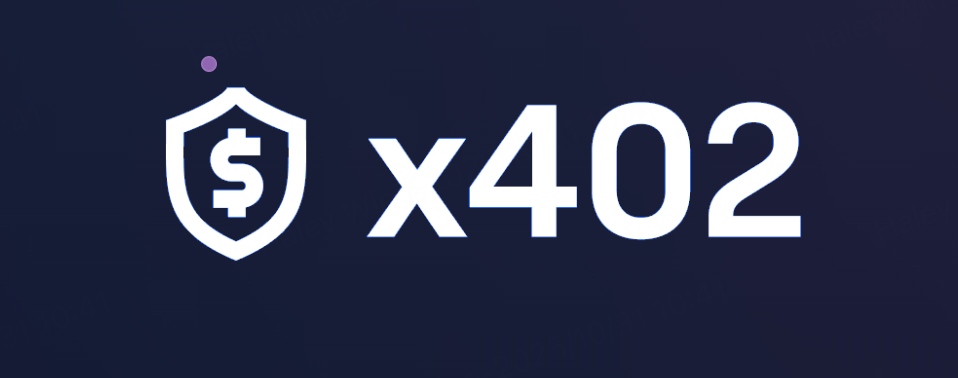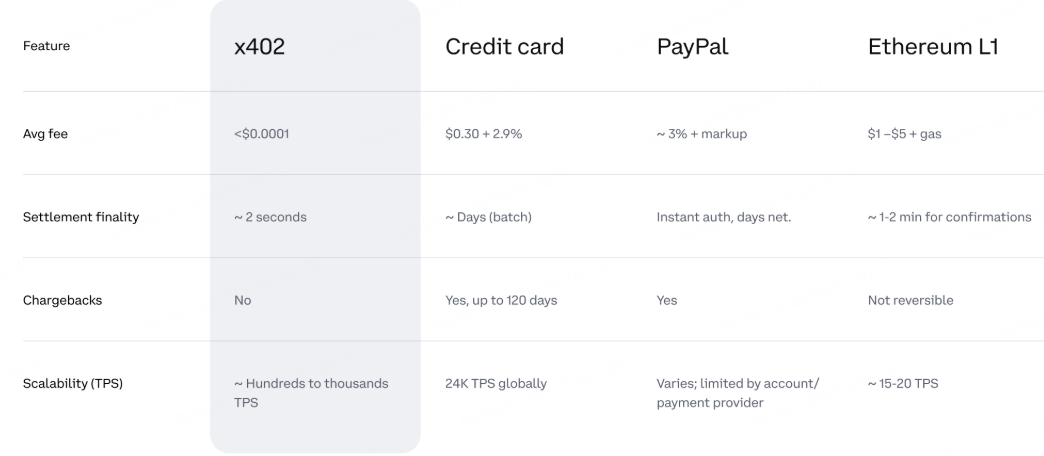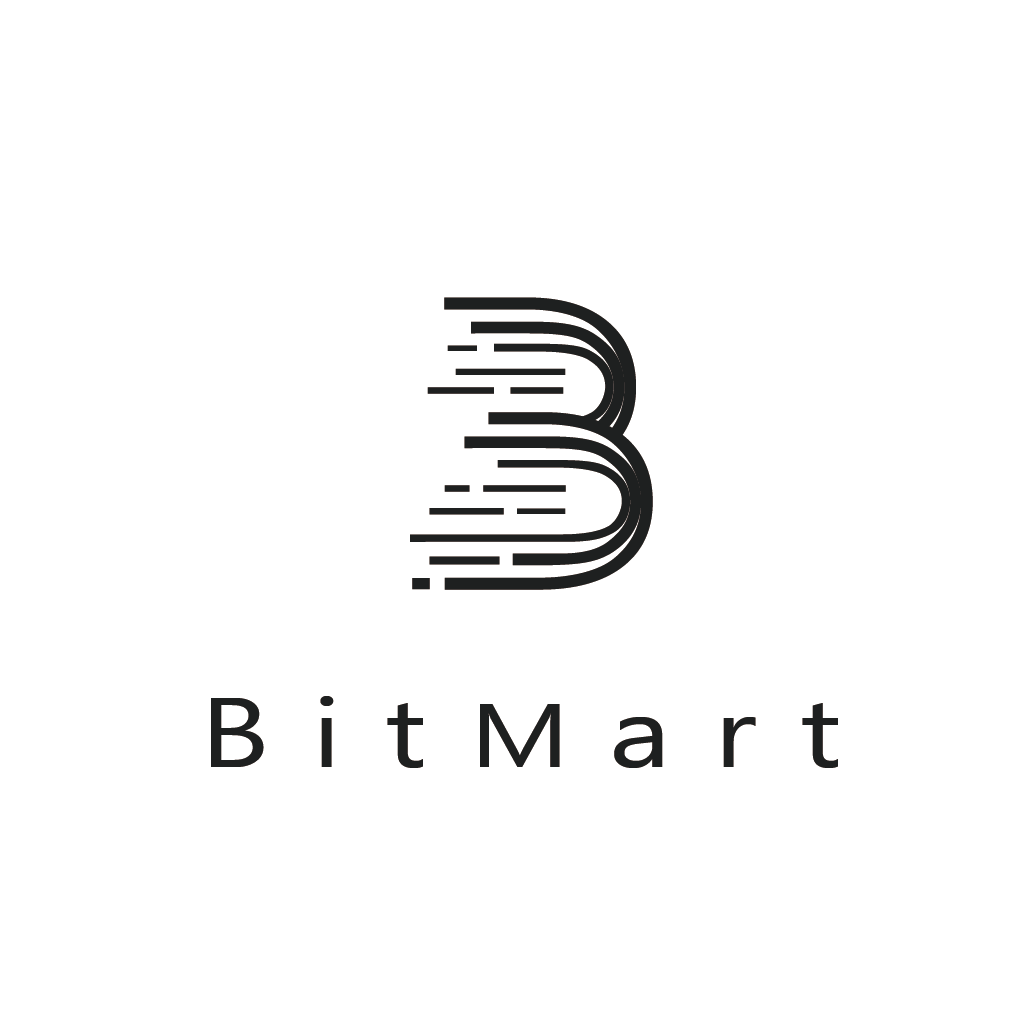
1. What is x402?
x402, jointly launched by Coinbase and Cloudflare, is a web-native payment protocol inspired by the long-dormant HTTP status code "402 Payment Required". Its core innovation lies in embedding payment logic into the web page interaction process, making payment an integral part of internet communication and creating a new "Payment as Interaction" model. Through x402, AI Agents, API services, and web applications can directly complete instant stablecoin payments within standard HTTP requests. Due to its inherent support for stablecoins, small amounts, high frequency, and low latency, x402 is suitable for AI Agents to purchase and use data, tools, and computing power on demand. It also allows Web2 services to access on-chain settlement with minimal modifications, eliminating the need for multiple hurdles such as registration, email, or complex signatures.
In practice, x402 reactivates the HTTP 402 status code to identify network requests that require payment. When the AI Agent attempts to access restricted resources (such as news content or API data), the server returns a 402 status code along with the payment amount, the recipient's wallet address, and available payment methods. The Agent automatically generates an equivalent stablecoin transaction and submits its signature. After verification by the coordinator, the server settles the transaction on the blockchain. Once payment is complete, access is granted, thus making payment a "natural extension of network interaction."

Image source: Coinbase
According to data comparisons provided by Coinbase, x402 comprehensively outperforms traditional payment methods and the Ethereum mainnet in terms of cost, speed, and performance. Its transaction fees are less than $0.0001, far lower than the approximately 3% fees charged by credit cards and PayPal, and avoids the high gas costs of the Ethereum mainnet. Settlement time is only about 2 seconds, with no refund mechanism, making transactions more secure and reliable. Furthermore, x402 eliminates the chargeback mechanism, reducing the risk of fraud and reverse transactions, and better aligning with the logic of on-chain immutability. In terms of performance, x402 can support hundreds to hundreds of thousands of TPS, far exceeding the Ethereum mainnet and credit card networks.

Image source: Coinbase
2.x402 Ecosystem Hot Projects
PING
PING is the first token issued on Base based on the x402 protocol. Although PING is a pure meme coin, some community users likened it to an inscription-like asset. In addition, it introduced the x402 concept to the public. As a result, the price of PING rose nearly 20 times in two days, and its market value once reached $80 million. It has now fallen back to around $18.7 million.
PayAI Network
PayAI Network gained public attention as a hands-on x402 provider. As an x402 protocol facilitator, it provides unified endpoint access for service providers processing x402 payments on the Solana and EVM networks, enabling verification and settlement of on-chain payments via HTTP resources under the x402 protocol. The market capitalization of the PAYAI token peaked at $70 million, but has since corrected to around $26 million.
Kite AI
Kite AI has launched its Agentic Internet (AIoT) foundational transaction layer, aiming to provide AI agents with a unified infrastructure for identity, payment, and governance, building an economic system that allows agents to autonomously collaborate, trade, and govern. By integrating the x402 protocol, Kite enables AI agents to complete on-chain payments and resource allocation without human intervention, and uses the ERC-8004 standard for identity and reputation verification, forming a closed loop of "trusted identity + automatic settlement." It has secured nearly $33 million in funding from leading institutions such as PayPal, General Catalyst, Coinbase, and Animoca. Overall, Kite currently boasts the best backing in the x402 sector, and it is already listed on pre-market trading platforms such as Binance and OKX, with a FDV of approximately $1.46 billion as of October 30th.
Pieverse
Pieverse is a TimeFi platform whose core concept is to enable people or resources that previously required time to match to find their corresponding targets more quickly through a series of mechanisms on the platform. Initially, it wasn't directly related to x402, but Pieverse solved the problem of BNB Chain's inability to support x402 by launching pieUSD, a USDT-encapsulated token supporting the ERC-3009 standard. It also upgraded x402, which previously only supported payments, to x402b. Simply put, Pieverse generates verifiable receipts for payments, proving that the payment was made between specific individuals, rather than through AI-generated transactions. As a $7 million strategic funding project led by Animoca Brands and UOB Ventures, it has secured a place in the BNB Chain x402 arena.
What happens to the 3.x402 after it cools down?
Although the x402 concept quickly became a hot topic in the market within two days of its launch, driving up the prices of several related projects, its popularity quickly subsided after a week. Leading projects in the sector, including PING and PayAI, experienced a nearly 80% correction from their peaks. However, the concept has not faded away. With the successive launches of new tokens such as Kite and Pieverse, market attention to the x402 ecosystem is expected to be reignited.
It's worth noting that, besides x402, another standard closely related to the AI Agent ecosystem—ERC-8004—is also gaining market favor. While x402 focuses on solving payment and settlement issues for AI Agents, ERC-8004 provides identity and reputation guarantees in the pre-payment stage. This standard establishes a decentralized identity authentication, reputation scoring, and qualification verification system for AI Agents by introducing three core mechanisms: an Identity Registry, a Reputation Registry, and a Validation Registry.
From a functional complementarity perspective, x402 and ERC-8004 together constitute the "payment + identity" foundational layer of the AI economic system: the former enables value transfer, while the latter ensures trust and access. Their combination is not only expected to drive the development of the AI Agent Economy, but may also become a key driver of the next wave of AI narratives.
Risk warning:
The information above is for reference only and should not be considered as advice to buy, sell, or hold any financial assets. All information is provided in good faith. However, we make no representations or warranties, express or implied, regarding the accuracy, adequacy, validity, reliability, availability, or completeness of such information.
All cryptocurrency investments (including financial products) are inherently highly speculative and carry a significant risk of loss. Past performance, hypothetical results, or simulated data are not indicative of future outcomes. The value of cryptocurrencies may rise or fall, and buying, selling, holding, or trading cryptocurrencies may involve significant risks. Before trading or holding cryptocurrencies, you should carefully assess whether such investments are suitable for you based on your investment objectives, financial situation, and risk tolerance. BitMart does not provide any investment, legal, or tax advice.
- 核心观点:x402协议推动AI与Web支付融合。
- 关键要素:
- 交易费低于$0.0001,结算仅2秒。
- 支持AI Agent自动支付与资源调用。
- 生态项目PING、Kite等市值快速增长。
- 市场影响:加速AI经济与链上结算普及。
- 时效性标注:中期影响。



